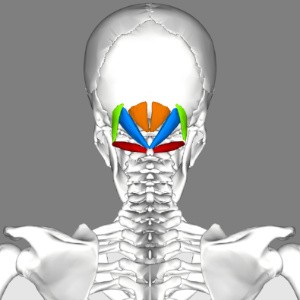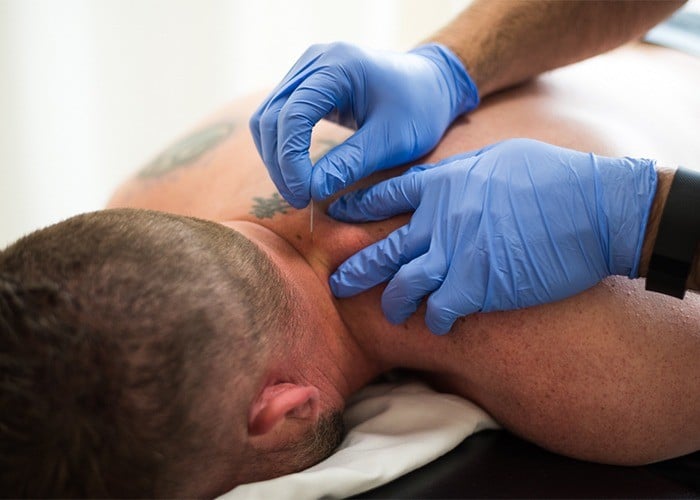Dry needling has been growing in popularity as more people seek quick remedies for chronic and acute pain as alternatives to pain killers. Dry needling has been proven to be very effective at releasing muscle knots, improving mobility, and relieving tension and pain. Because of this it has become a favorite choice for headache relief.
We sit down with Nick Sutton, PT, DPT at our North Phoenix location, to talk about the benefits of dry needling for treating headaches and address some common concerns about dry needling.
Finding the Right Solution
Many people don’t realize that their headaches are being caused by a neuromuscular issue. Usually, the temporary relief offered by Tylenol or ibuprofen is enough to get their minds off the pain, but symptoms will eventually come back in what is referred to as a “medication overuse headache”. In these cases, a doctor offering a prescription or dosage increase is counterproductive to getting better. Using pain killers to treat a neuromuscular problem serves to mask the pain but doesn’t treat the issue at its core allowing it to advance and potentially create an unhealthy cycle and dependence on pain killers.
It’s not often that a patient enters a clinic specifically asking for dry needling. When a patient chooses physical therapy, they may not be aware of all the different styles of treatment available to them. Communication is key, if you experience chronic headaches or you simply avoid certain tasks and limit certain movements because it could trigger a headache let your physical therapist know, you are likely a good candidate for dry needling. Always remember that you and your physical therapist are a team.
Will Dry Needling for Headaches Help Me?
Absolutely! Dry needling targets trigger points in the muscles and tissue to help alleviate tension, preventing headaches and helping relieve tension caused by headaches. Headaches can be broken into four main types: tension, migraine, cluster and sinus. Tension headaches are the most responsive to dry needling because the root cause is muscle tension. Nick gives more insight into the other three types of headaches. Migraines for instance, may not always originate from neuromuscular issues but they can still cause muscle tension, intensifying the overall pain or limiting the overall mobility the body has. An assessment will find if a migraine is being caused by muscle tension, nerve irritation or blood flow restriction to the head. In the latter two, a physical therapist may recommend cardiovascular training or other soft tissue mobilization in addition to dry needling.
Nick points out that, “there is no one technique, one approach, one anything that is effective by itself.” So, while dry needling is very effective in providing quick relief for headaches, it is only part of a comprehensive solution. The muscles loosened up by dry needling now have a new range of motion and function that they are not used to. This means that now it’s our due diligence to retrain those muscles in order to see the longest-lasting results; otherwise, the muscles will revert back to a state they are familiar with.
Learn about the different options physical therapy offers to help with your headaches:
Have a Headache? Find Relief with PT
Physical Therapy for Headaches and Migraines
How Do I Know My Headaches Are from Muscle Tension?
The most common areas of the body that contribute to tension headaches are the upper back, shoulders and neck. Specifically, if you experience tightness or strain in the following muscles, then they are likely the cause of your headaches.
1. Upper Trapezius

The trapezius is a group of muscles that runs along the upper back, shoulders and neck. Most patients seeking dry needling suffer from muscle tension in the upper portion of this group.
2. Suboccipital Muscles

The suboccipital muscles are a group of muscles located where the base of the skull meets the spine. This is a very common area where patients experience tension. Yes, we can target knots in these muscles for dry needling.
3. Sternocleidomastoid (sternomastoid)

The sternomastoid is a muscle that runs down the side and front of the neck. Many dry needling patients experience tension in this muscle. It ties with the suboccipital muscles for the 2nd most common contributor to tension headaches.
What Is the Difference Between Dry Needling and Acupuncture?
Despite using the same tool, a solid monofilament needle, Nick explains that dry needling and acupuncture are very different in theory and technique. Acupuncture focuses on the meridian lines, or “energy channels”, where an issue is present whereas dry needling identifies specific knots in a muscle and releases them from the inside out. That being said, the two disciplines are not interchangeable.
Does Dry Needling Hurt?
Patients hardly notice the needle insertion, sometimes they don’t feel the needle at all. What patients will feel is the twitch response. Nick explains that the twitch feels like a charley horse or muscle spasm for a few moments as the muscle releases.
After treatment, patients usually feel sore for 2-3 days. The soreness is akin to the feeling after an intense workout.
How Long Does Dry Needling Take to Work?
Results can be seen immediately. Patients feel tension relief after just one dry needling session, but like a car, you don’t just change the tires once. Patients will often choose dry needling again to stay on top of their health. Individuals who have severe or chronic headaches may not be back to 100% after just one session, but the pain is noticeably reduced.
Maintenance is important, for the longest-lasting results work with your physical therapist to find exercises to help retrain your muscles to their new range of motion.
Final Thoughts
Dry needling is a versatile treatment with many benefits and applications. Nick states that it’s not often a treatment can be so effective in just one session. The drastic change patients get to experience is rewarding as a physical therapist.
Patients are more empowered than they realize. As dry needling becomes more popular and accepted, we can see it being requested in sports medicine, spine rehabilitation, trauma and surgical rehabilitation, and in many more areas as there is rarely a condition that couldn’t benefit from it.
Learn more about Dry Needling at Spooner Physical Therapy. Ready to schedule an appointment? Schedule an appointment or complimentary movement screen with a Spooner physical therapist at one of our locations throughout the valley.
*Dry needling is considered to be an advanced skill not everyone is qualified to practice. In the world of physical therapy, each state has its own combination of hours practiced, written tests and practical tests required to be certified for dry needling. At Spooner Physical Therapy our dry needling specialists have years of practice and certifications under their belts so you know you are getting top quality care.

